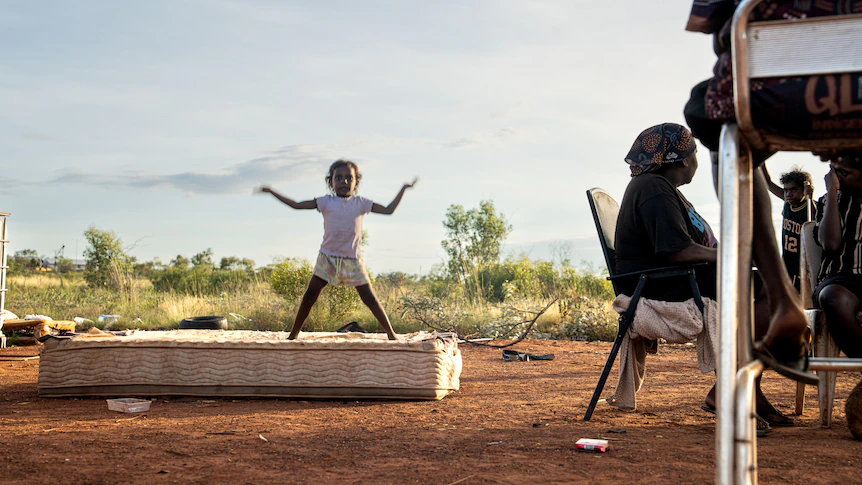By Jayden O’neill
Copyright abc

Many Aboriginal people in Tennant Creek live in overcrowded makeshift shelters with no running water or electricity, as they wait up to a decade for a home.
But experts say the social housing being built is not safe for the climate of today, let alone into the future.
The air is thick with the smell of petrichor in Tennant Creek.
Petrichor is the smell of rain we all know and love as it hits the hot ground in a sun shower.
To most Australians, it brings the relief of a cool breeze and rain on a hot day.
But today in Tennant Creek, it doesn’t conjure the same reaction.
Today, it’s the smell of water hitting the hard red ochre dirt as Marcia Morgan hoses down her front yard on the outskirts of town.
It’s nearly 4pm, the temperature is still 41 degrees Celsius, and the heat is radiating from all directions.
“I’m hosing it down so that Matilda can sleep out here tonight, otherwise it’s too hot,” she says.
Aunty Matilda Holmes has come to town for dialysis, but she sleeps outside on the ground because there’s no room in Marcia’s house, where three generations share two bedrooms.
Matilda usually can’t get to sleep until about 2am or 3am when it gets cool, Marcia says. It’s too hot to sleep.
Tennant Creek sits in the centre of the Northern Territory, 10 hours’ drive south of Darwin.
The average maximum temperature across the year is 32.1C.
From 1994 to 2024, an average of 142 days each year reached 35C — the temperature considered as extreme heat by the CSIRO, Australia’s peak science organisation.
It measures days over 35C because it’s the temperature at which the body begins to show signs of struggle.
It’s an issue across the Northern Territory, which has 12 times the national rate of homelessness, and 87 per cent of those homeless are Indigenous.
A warming climate
Rusted sheets of tin from the side of Dudley Hines’s home are banging together in a midday breeze.
Tarps and cloth have been used to cover the gaps between the sheet metal walls and the roof.
There’s no door — just two mattresses, a clothes rack, a torn-up couch and a broken washing machine.
Dudley lives here with his wife Daisy, his adult daughter and her partner, both of whom have full-time jobs.
The only way for them to stay cool is to sit outside in the shade and put ice bought from the service station in their drinking water.
Dudley remembers a time — when working on cattle stations in the 60s and 70s — when the climate was cooler.
“I’d start walking the cattle at 3, 4 o’clock in the afternoon when it was nice and cool,” he says.
“That was before, not today, all-day hot.”
Dudley’s memory is backed up by Bureau of Meteorology data.
From 1965 to 1994 in Tennant Creek, there were an average of 130 days per year above 35C.
That average rose to 142 days over the following three decades, and data also shows the days are taking longer to cool down.
Dudley and his family have been on a public housing waitlist for over five years.
Considering the standard wait time for a house in town, he could be waiting until 2030 — 10 years since he applied.
If emissions are reduced substantially, by the 2030s the CSIRO estimates an average of 162 days each year will reach 35C or more.
By 2070 it would be 184.
That is under a medium carbon emissions scenario, where the world reaches peak emissions in 2040.
But if emissions continue to rapidly increase throughout the century, in the 2070s it’s estimated that 209 days per year will hit 35C.
That’s 75 more days per year than when Dudley worked on farms.
CSIRO climate impacts lead Jaci Brown says, on average, temperatures are not getting any cooler.
“Scientists have known for half a century that as we increase greenhouse gases, the planet will warm up, and we’re seeing this play out,” Dr Brown says.
She says it’s becoming impossible to stop the global average temperature from rising 1C, and that the impacts are already being seen.
The human impact of heat
Simon Quilty has worked as a doctor in remote NT communities for over 20 years. Now a PhD candidate at the Australian National University, he specialises in how heat and housing design impact human health.
He’s a founder of Wilya Janta, a not-for-profit organisation promoting cultural and thermal design in Indigenous community housing.
He says the Northern Territory is falling behind when it comes to curbing the negative impacts that come with poor housing.
A lot of the houses in Tennant Creek don’t have air conditioning and become hot boxes through the heat of the day.
In homes that do have air conditioning, everyone crowds in to get cool — creating what experts call the perfect conditions for rheumatic heart disease (RHD).
RHD is an entirely preventable disease which is linked to overcrowding, with 81 per cent of Australian cases affecting Indigenous Australians, according to Australian Institute of Health and Welfare (AIHW) data.
It starts as a viral infection or skin sore, and, if left untreated, can lead to a life-threatening disease.
A 2023 AIHW report shows the disease is by far the most prevalent in the Northern Territory.
Bonita Thompson lives at Drive-In Camp, a town camp on the outskirts of Tennant Creek.
Two of her grandchildren have RHD.
Doctors have told her it’s important for them to eat the right foods and take their medicine — but it’s not that simple.
“We have no fridge to keep the right medicines for them, or the right food to keep in the fridge,” she says.
Drive-In Camp is about 6 kilometres from the Tennant Creek town centre.
There’s no electricity or water, but out here Bonita is more in touch with her family and culture.
“I’ve lived in community housing, but sometime because of the rent or the amount of families you’d have in there, [it] was too much,” she says.
“Sometimes family would come in to visit, they’d stay for medical reasons, but then it just got too hard for me to live in a house.
“I didn’t really want [the] housing [department] to come and see us every now and then and say ‘you’re overcrowded, you’ll have to send them away’.
“So I moved back out here to Drive-In Camp where you can have peace.”
Many Aboriginal people here have strong family connections, and there’s a cultural responsibility to care for and support relatives.
Dr Quilty says the combination of heat, poorly-designed housing and overcrowding can give rise to other tensions.
“Forget about trying to take your medicine for diabetes, because you don’t have enough money to pay for regular food and your fridge is off anyway,” he says.
More hot days, more health issues
With more than half the year predicted to reach over 35C in Tennant Creek by 2070, Dr Quilty says something must be done to minimise Indigenous Australians’ exposure to such poor living conditions.
“We know that this increasing wave of heat is worsening overcrowding and living conditions,” Dr Quilty says.
“We need to be planning for the future right now, because it is happening right now.”
Dr Quilty says even the “lucky ones” who have community housing aren’t much better off.
“The houses being built at the moment for remote Indigenous communities would be illegal to build in any other state or territory, except for Tasmania,” he says.
All Australian jurisdictions, besides the NT and Tasmania, impose 7-star building code tied to thermal performance on home builds.
The NT has built under a 5-star building code since 2009, and shows no signs of changing that despite facing extreme temperatures.
“These houses are incredibly poorly equipped for the weather of today, not even considering what the weather’s going to be in 10 years’ time,” Dr Quilty says.
Wilya Janta has proposed home designs that meet 7-star ratings, which Dr Quilty says “works better for culture, and a climate of 2090”, to some Aboriginal peak housing bodies and the Barkly Regional Council.
Changes include: Having uniform air conditioning throughout to prevent crowding into small rooms, reducing the risk of spreading disease.
A deep verandah to provide shelter from the harsh summer sun throughout the day, and for visiting relatives to stay undercover, without crowding the house.
A large breezeway crafted from local mudbricks, made from ant hills and spinifex.
And outdoor kitchens that allow residents to cook outdoors and not add unnecessary heat to the house.
The first house build using this design, which is privately funded, is underway in Adelaide and will later be transported to Tennant Creek.
Wilya Janta hopes construction will be complete before the end of 2025.
Speaking out, but never heard
Bonita says she is hopeful that one day children will get to live a cultural life on country, in houses that protect them from the elements.
“We love living here, even though it’s got no water or power,” she says.
Bonita spoke to Malcolm Turnbull in 2018 when the then-prime minister visited Tennant Creek — the first PM to visit since 1982.
She told him how she’d been working every day just to put food on the table for her family.
He called her an “inspiration” to her family, and spoke of how a lack of suitable housing was the number one issue facing Tennant Creek.
Seven years later, as we sit in 40-degree heat, sweat dripping from our faces, under the only tree near her home that provides any shade, I prepare to ask Bonita about her living situation.
But she gets the first question in.
“Is this actually going to change anything for my people? I’ve spoken to media before, and nothing has happened.”
I have no answer.
Reporting: Jayden O’Neill
Images and video: Jayden O’Neill
Production: Annabel Bowles
Graphics: Jessica Henderson, Randi Dahnial, Nikita Kafetzis
Data: My Climate View, Australian Institute of Health and Welfare
Editing: Emily Sakzewski and Alicia Perera



